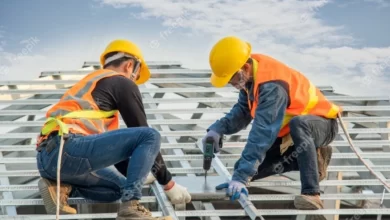How Many Layers of Roofing Material Is OK for Your Home?

When it comes to maintaining a sturdy and reliable roof, many homeowners wonder how many layers of roofing material their home can support. Consulting a professional roofing contractor is essential to making this decision, as it depends on various factors including structural integrity and local building codes. Homes are subjected to a wide range of weather conditions, from sweltering summers to harsh winters. These changing climates place a lot of demand on roofing materials and installation practices. A common question homeowners often ask is, “How many layers of roofing material are appropriate for my home?” Let’s dive into this topic and explore what factors to consider when it comes to layering roofing materials, including building regulations, structural integrity, and long-term maintenance.
Understanding Roofing Layers
When adding a new roof, homeowners sometimes choose to place new shingles over the old ones, a process known as “re-roofing.” This method can be a cost-effective alternative to a complete roof replacement because it saves time and reduces labor costs. However, while re-roofing may be faster and less expensive upfront, there are several critical factors to consider before deciding to go this route.
How Many Layers of Roofing Material Are Allowed?
Legal and Structural Limitations
In many regions, building codes permit up to two layers of roofing material. The reasoning behind this limitation is primarily structural. Every layer of roofing material adds weight to the roof, which can place stress on the home’s framework. Too many layers, especially on older homes or houses not designed for such weight, can result in structural damage.
Before deciding to add a second layer, it’s essential to inspect the current roof’s condition. If the existing shingles are curling, buckling, or show signs of other damage, re-roofing may not be an option. These underlying issues can compromise the effectiveness of the new layer and may result in future problems like leaks or structural damage.
Pros and Cons of Multiple Roofing Layers
Pros:
- Cost-Effective: Re-roofing eliminates the need for tearing off the old shingles, which reduces labor costs and disposal fees.
- Faster Installation: Since there’s no tear-off process, re-roofing is generally completed quicker than a full replacement.
Cons:
- Hidden Damage: Placing a new layer of shingles over old ones doesn’t address underlying issues like leaks, rot, or water damage. This could lead to bigger problems later.
- Increased Weight: Every new layer adds significant weight to the roof. Over time, this additional load can compromise the structural integrity of your home’s roof.
- Shortened Lifespan: Multiple layers can trap heat and moisture, which may accelerate the wear and tear on the new shingles, leading to a shorter lifespan.
Factors to Consider Before Re-roofing
- Roof Condition: Have a professional roofing contractor inspect the current state of your roof. If your shingles are damaged or if there’s underlying water damage, adding a new layer may only mask the problem rather than solve it.
- Structural Capacity: Make sure that your home’s structure can handle the additional weight of another layer of shingles. Overloading your roof could lead to costly repairs in the future or even compromise the safety of your home.
- Climate Considerations: The local climate plays a crucial role in determining whether adding a layer is a good idea. Homes in areas with extreme temperatures or heavy snowfall should be particularly cautious about adding multiple layers. The roof needs to withstand these conditions, and excess layers could trap moisture or heat, both of which can cause faster deterioration.
When Should You Opt for a Full Roof Replacement?
In some cases, a complete roof replacement is the safer and more long-term solution. If your roof has experienced significant wear and tear, or if you’ve already added one layer of shingles, it might be time to consider replacing the entire roof. While this option requires a higher initial investment, it allows roofing professionals to inspect and address any structural damage, ensuring that your home is protected for years to come.
Additionally, a full replacement gives you the opportunity to upgrade your roofing material. Many modern materials are designed to withstand severe weather conditions, provide better insulation, and last longer than traditional asphalt shingles. Replacing the entire roof also gives you peace of mind knowing that the underlying structure is sound and ready to handle the elements.
Consulting a Roofing Contractor
Deciding whether to add a layer or replace the entire roof is not a decision to be taken lightly. It involves considering multiple factors such as cost, safety, and long-term durability. Consulting with an experienced roofing contractor is the best way to ensure that your decision aligns with your home’s specific needs. Roofing professionals can assess the current state of your roof, check for underlying damage, and advise on the best course of action.
They can also help you navigate local building codes and make sure that your home is compliant with any regulations regarding roofing materials and installation practices.
Conclusion
The question of how many layers of roofing material is acceptable depends on several key factors, including the current condition of your roof, your home’s structural integrity, and your local climate. While re-roofing can be a more affordable and faster option in the short term, it’s essential to weigh the pros and cons carefully before making a decision. Always consult a professional roofing contractor to guide you through the process and ensure that your roof remains strong, safe, and durable for years to come.
Ensuring your roof can handle the extra load is critical to maintaining the structural integrity of your home.






